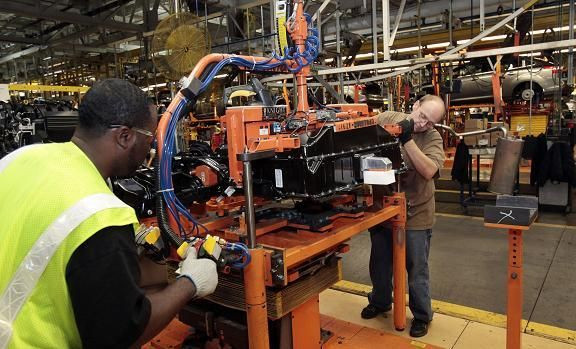US January Jobs Report 2013: Is The Nation's Economic Recovery For Real?

The U.S. created 157,000 jobs in January, broadly in line with the consensus forecast, and the unemployment rate ticked up to 7.9 percent. But the economy added more jobs in 2012 than previously estimated, with a large chunk coming in the final months of the year. Economists believe this should help soothe any concerns stemming from Wednesday’s report of a negative gross domestic product print that the U.S. economy is headed for a recession.
The jobless rate rose from 7.8 percent to 7.9 percent as the Bureau of Labor Statistics conducted annual revisions to its estimate of the U.S. population.
Economists polled by Reuters had expected employers to add 160,000 jobs and the unemployment rate to hold steady at 7.8 percent last month.
“Things aren’t getting worse, but they are also not getting appreciably better,” said Raymond James Chief Economist Scott Brown. “We appear to be adding jobs at a steady pace that’s consistent with the overall growth in the size of the labor force, but we are still not really making up a whole lot of ground that was lost in the labor market during the downturn.”
Here are four takeaways from the January jobs report:
- 1. 2012 was stronger.
Job gains in November and December were revised up by a combined 127,000. Payrolls increased at a monthly average of 201,000 in the fourth quarter, which suggests the economy was in a pretty healthy state.
For 2012 as a whole, the average monthly jobs gain bounced up to a healthy 181,000, pushing last year ahead of 2011's monthly average of 175,000 new jobs. That’s enough to make 2012 the best year for job growth since 2005.
In addition, after incorporating the annual benchmark revision, the level of payroll employment in March 2012 was revised up by a massive 422,000, suggesting that job growth was roughly 35,000 per month stronger than we previously thought in 2011 and early 2012, Paul Ashworth, chief U.S. economist at Capital Economics, said in a note to clients.
- 2. But don’t get too excited about the rise in average hourly earnings.
Average hourly earnings were up 4 cents in January. While the increase could be seen as tentative signs of mounting confidence among both employers and workers, it’s not going to help drive consumer spending.
For the year, average hourly wages rose 2.1 percent, which is a bit above the last inflation number, which was up 1.7 percent on the year in December.
“The average hourly earnings were up more or less in line with the inflation numbers we’ve seen over the last year, so for a typical worker, they are simply running in place.” Brown said. “Moreover, payroll taxes have gone up 2 percent now in January, so that wage gain was simply wiped out by higher taxes for your typical worker.”
“So there’s not a whole lot of fuel for consumer spending growth,” Brown added.
- 3. Is the recovery for real?
Looking at the detail for January, the construction sector added 28,000, reflecting the Sandy clean-up and the housing recovery. The retail sector added 33,000, suggesting that the payroll tax cut expiry has been less damaging than the slump in consumer confidence suggests. The only disappointment in the payroll figures is the 8,000 decline in temporary employment.
The negative fourth-quarter GDP numbers were a bit distorted because of the drop in defense spending and the lighter inventories, but the basic demand – consume spending, business fixed income investment – were relatively healthy. And there may also have been a payback from a strong third quarter.
“We are in a very gradual recovery,” Brown said. “The housing sector looks like to have turned around, you are still seeing a lot of pressure on state and local government budgets, you’ve got the payroll tax increase which is going to dampen consumer spending to some extent, and you have the sequester, which is out there and may dampen government spending even more at the federal level in the remainder of the year.”
“So I think the recovery will continue to chug along, but not really the 3 percent to 4 percent kind of growth that we’d like to see to boost the job market,” Brown added.
- 4. No reason for the Fed to take its foot off the gas pedal.
The conditionality for a change in the fed funds rate is clear: The thresholds are 6.5 percent unemployment and projected inflation of less than 2.5 percent.
“With inflation trending below their target, there’s nothing that should push them to take their foot off the gas pedal here,” Brown said. “The one caveat is that they are watching for any signs that they might be sowing the seeds of future financial instability.”
The conditions for a change in the QE policy are not so clear. In December, the committee said it would continue its purchases of Treasury and agency mortgage-backed securities as long as the outlook for the labor market does not improve "substantially."
“I don’t think this is it,” Brown said. “I think they want to see nonfarm payrolls up 250,000 to 300,000 per month for several months in a row.”
Recently, Fed officials have sounded differing opinions on how long it should continue buying bonds, with some leaning toward ending the purchases before the end of the year. Some Fed officials are worried about the potential for "financial instability" if the Fed's balance sheet grows too large.
Since the financial crisis of 2008 and 2009, the central bank’s portfolio has more than tripled and has topped $3 trillion for the first time as the Fed continued with its easy-money policy.
© Copyright IBTimes 2024. All rights reserved.






















